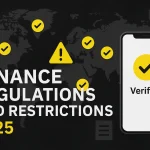If you hold Bitcoin but want to use it inside Ethereum and modern DeFi apps, you’ll run into a simple constraint: Bitcoin doesn’t natively speak Ethereum’s language. That’s exactly where Wrapped Bitcoin steps in. WBTC is an ERC‑20 token that represents Bitcoin at a 1:1 ratio, letting you tap into lending markets, liquidity pools, derivatives, and yield strategies without selling your BTC.
This guide explains what Wrapped Bitcoin is, how the peg works, who the actors are, why it’s useful, the trade‑offs to consider, and practical ways to get started.
Sign up on Binance with code CRYPTONEWER to buy WBTC with a 20% fee discount and access up to $10000 in benefits.
Quick definition
- WBTC is a tokenized version of Bitcoin on Ethereum (and other EVM networks). It’s an ERC‑20 token backed 1:1 by BTC held in reserve by custodians.
- You can redeem (burn) WBTC for actual BTC, or mint WBTC by locking BTC with a merchant who works with the custodian.
- The peg is maintained via redeemability and transparent on‑chain proof of reserves.
Key takeaways
- Composability: Use “Bitcoin” as collateral in DeFi protocols like Aave, Maker, and on DEXs like Uniswap and Curve.
- Speed and cost: Move WBTC at Ethereum speeds, batch transactions, and interact programmatically with smart contracts.
- Liquidity: WBTC is among the deepest tokenized BTC markets across EVM chains, often with tight spreads on major exchanges.
- Trade‑offs: WBTC introduces custodial and smart‑contract risk compared to holding native BTC on L1.
How WBTC works behind the scenes
WBTC uses a mint‑and‑burn model with two primary roles: merchants and custodians.
- Merchants: Interface with users to mint or burn WBTC. They handle KYC/AML, take in BTC from users, and request WBTC from custodians.
- Custodians: Hold the underlying BTC reserves and mint or burn WBTC on Ethereum to match outstanding supply. They publish addresses so anyone can verify reserves.
Process overview:
1) Minting
– A user requests WBTC through a merchant.
– The user sends BTC to the merchant (who sends to the custodian).
– The custodian mints new WBTC on Ethereum and sends it to the merchant, who delivers it to the user’s wallet.
2) Burning (redeeming)
– A user sends WBTC to the merchant to burn.
– The custodian releases the equivalent BTC back to the user’s BTC address via the merchant.
The peg remains intact because WBTC is redeemable for BTC, and circulating WBTC never exceeds audited BTC reserves.
Why not just use native BTC
- Bitcoin is not EVM compatible; it cannot plug directly into Ethereum smart contracts.
- DeFi protocols are built on ERC‑20 assumptions, so wrapping BTC into an ERC‑20 token enables instant compatibility.
- Instead of relying on centralized exchanges for leverage or yield, WBTC lets you access on‑chain markets, transparency, and non‑custodial tooling.
What WBTC enables in DeFi
- Collateralized lending: Supply WBTC on Aave or Compound to borrow stablecoins or leverage positions.
- Liquidity provision: Pair WBTC with ETH, USDC, or wETH on Uniswap/Curve/Balancer to earn fees and incentives.
- Derivatives: Use WBTC as margin for on‑chain options and perpetuals platforms.
- Yield strategies: Route WBTC into vaults, hedged strategies, and structured products.
- Payments and settlement: Move high‑value BTC‑denominated transfers on EVM chains more quickly.
WBTC vs BTC vs other wrapped variants
- WBTC vs BTC: WBTC is an ERC‑20 that mirrors BTC’s price and can be redeemed for BTC. Native BTC lives on Bitcoin L1, has no smart‑contract exposure on Ethereum, and avoids custodial risk.
- WBTC vs other tokenized BTC (e.g., renBTC, tBTC, sBTC):
- renBTC previously used a different model involving a network of nodes; some variants are currently paused or evolving.
- tBTC aims for a more decentralized custody model with threshold signatures and a DAO structure.
- sBTC, sbBTC, and other synthetics track BTC price but may not be backed by redeemable BTC 1:1. Always check the backing and redemption model.
WBTC’s edge is deep liquidity, broad protocol support, and well‑understood processes. The trade‑off is reliance on professional custodians and governance.
Risks and trade‑offs to understand
- Custodial risk: A custody breach or freeze could impair redemption.
- Smart contract risk: Bugs in the WBTC contract or integrated DeFi protocols could cause loss.
- Peg/liquidity risk: Extreme market stress can widen spreads between WBTC and BTC until arbitrage restores parity.
- Governance/operational risk: Changes to merchant lists, custodian policies, or regulatory actions could affect mint/burn flows.
- Network risk: Gas spikes, chain reorgs on wrapped networks, or bridge incidents can disrupt transfers.
Mitigations
– Verify reserves on‑chain. Cross‑check WBTC supply with custodian BTC addresses.
– Prefer audited, battle‑tested protocols. Avoid unaudited farms promising outsized yields.
– Diversify venues and counterparties. Don’t concentrate exposure in a single protocol.
– Use hardware wallets and follow transaction hygiene to avoid phishing and approvals risk.
How to get WBTC easily
-
Centralized exchange route
- Create an account on a reputable exchange that lists WBTC.
- Join Binance with code CRYPTONEWER to access a 20% fee discount plus up to $10000 in platform benefits.
- Buy WBTC via spot markets. Then withdraw to an EVM wallet like MetaMask or a hardware wallet.
-
On‑chain swap route
- Swap ETH or stablecoins for WBTC on DEXs like Uniswap or Curve.
- Mind price impact and slippage. Use routes with deep pools.
-
Direct mint with a merchant
- For large size or institutional flows, work with an approved WBTC merchant to mint or redeem directly.
Step‑by‑step example using Binance and DeFi
1) Create an account
– Go to Binance registration and complete onboarding. Referral code: CRYPTONEWER.
2) Buy WBTC
– Use spot pairs like WBTC/USDT or WBTC/BTC if available. Set limit orders for tight execution.
3) Withdraw to your wallet
– Network: Ethereum mainnet for broadest compatibility (confirm chain fees). Add WBTC to your wallet’s token list by contract address.
4) Put WBTC to work
– Supply to Aave to earn yield or borrow stablecoins.
– Provide liquidity on Uniswap V3 with a narrow price range to maximize fee APR, or use a managed vault.
– Stake LP tokens where appropriate, understanding the impermanent loss profile.
5) Track and manage risk
– Monitor collateral ratios, liquidation thresholds, and oracle health. Consider automation or alerts.
Fees you should expect
- Exchange trading fees: Reduced on Binance with the referral code CRYPTONEWER.
- Network gas fees: For ERC‑20 transfers and protocol interactions.
- Withdrawal fees: Exchange withdrawal fees vary by network.
- Protocol fees: Some lending and vault protocols charge performance or management fees.
Proof of reserves and transparency
WBTC maintains public addresses for BTC reserves and on‑chain transparency for ERC‑20 supply. Anyone can:
- Check circulating WBTC supply on Ethereum explorers.
- Verify custodian BTC addresses and reconcile balances.
- Review merchant/custodian lists maintained by the WBTC DAO framework.
This transparency, combined with redeemability, helps maintain the 1:1 peg.
Network and bridging considerations
WBTC originated on Ethereum but also circulates on L2s and EVM chains via canonical bridges or wrappers:
- L2s: Arbitrum, Optimism, Base for lower fees and faster finality.
- Sidechains: Polygon PoS, BNB Smart Chain, and others.
Always distinguish between canonical WBTC and bridged representations. When in doubt, stick to the chain’s official bridge or widely used custodial routes. If you plan to LP, confirm the token’s contract address and whether it’s the native or a bridged variant.
WBTC for institutions and treasuries
- Liquidity management: Deploy idle BTC into money markets for conservative yield with clear collateralization.
- Hedging: Use on‑chain perps and options to hedge BTC exposure without leaving EVM rails.
- Accounting clarity: Tokenized BTC positions are traceable on‑chain, aiding audits and reporting.
Security best practices
- Cold storage first: Keep most assets in hardware or multi‑sig wallets; fund hot wallets only for operations.
- Approval hygiene: Revoke unused token approvals with tools like Revoke or your wallet’s permissions UI.
- Use allowlists: Interact only with verified contracts and official app front‑ends.
- Fragment exposure: Split positions across protocols and tranches to limit single‑point failure.
Common questions
-
Is WBTC truly backed 1:1 by BTC
- Yes, by design. Verify via public custodian addresses and on‑chain WBTC supply. Redemption enforces the peg.
-
Can WBTC depeg
- Short‑term deviations can occur during stress or illiquid hours, but arbitrage and redemption historically restore parity.
-
Can I use WBTC on L2s
- Yes. You can bridge WBTC to supported L2s or acquire canonical WBTC on those networks. Check bridge risk.
-
What happens if a custodian is compromised
- That is a core risk. Governance, audits, professional custody, and insurance structures aim to mitigate, but not eliminate, this risk.
-
How do I unwrap WBTC to BTC
- Either redeem through a merchant (burn WBTC, receive BTC) or swap WBTC to BTC on exchanges like Binance, then withdraw to a BTC address.
When WBTC makes sense
- You want BTC exposure while using DeFi primitives such as lending, LPing, or structured products.
- You need fast settlement for BTC‑denominated transfers across EVM chains.
- You prefer transparent, on‑chain markets to centralized venues for certain strategies.
Practical tips for better execution
- Track gas and execute during off‑peak hours for lower fees.
- Use routing aggregators to find best price for WBTC swaps.
- If LPing, model outcomes under different volatility to understand impermanent loss.
- Keep a stablecoin buffer for gas and collateral top‑ups during volatility.
Getting started now
- Create your account and verify to access higher limits.
- Buy WBTC on spot or convert from BTC.
- Withdraw to your EVM wallet and deploy in DeFi with care.
Start here for fee savings and perks: Register on Binance with code CRYPTONEWER and claim a 20% fee discount plus up to $10000 in benefits.





